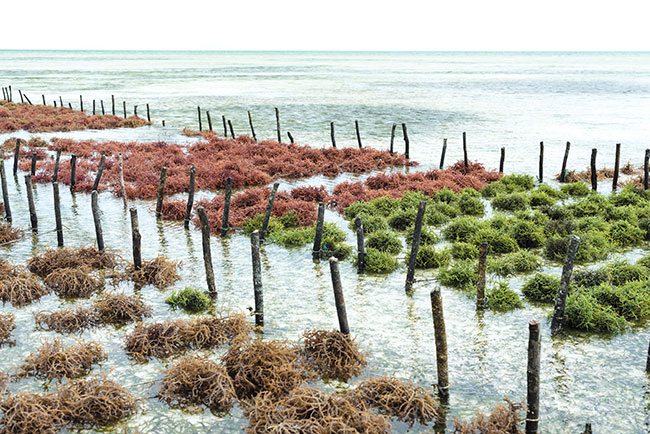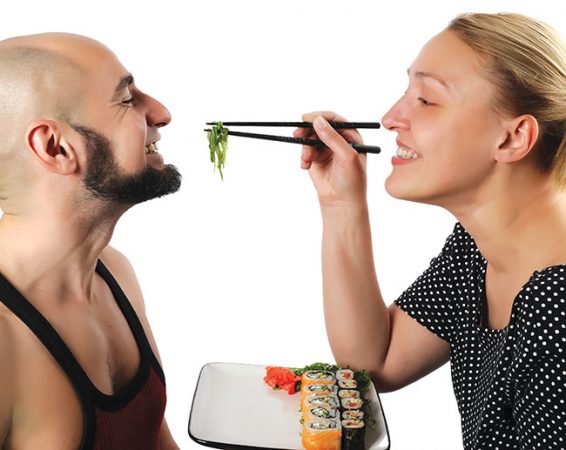
Seaweed farming gains traction
November 20, 2019
By Heather Wiedenhoft
Norway’s experience highlights multi-industry collaboration in addressing challenges in seaweed farming and marketing
 Rows of seaweed on a seaweed farm. Researchers are looking at the seabed for a new generation of ‘crops’ to support the world’s rapidly growing population. All photos: Adobe Stock
Rows of seaweed on a seaweed farm. Researchers are looking at the seabed for a new generation of ‘crops’ to support the world’s rapidly growing population. All photos: Adobe Stock It’s a move towards a more sustainable and responsible agriculture: growing marine algae (seaweed) would require no pesticides, hormones, and are virtually drought- resistant. And researchers have found that some types of algae grown in a cultured environment often produce a higher biomass of algae per cubic area than land-based crops like wheat and corn. The leafy sea crop is a low-calorie, low-fat source of protein and iron, and is full of nutrients like vitamin K, folic acid and calcium.
Norway, world-leading producer of farmed Atlantic salmon, is already on the map for utilizing natural stocks of algae and kelp in its cold, clean northern waters.
Since the beginning of salmon farming in the 1970s, Norway has been working hard to advance techniques in aquaculture and mariculture based on sustainable and ecologically safe growth and harvest practices. They have one of the most successful salmon farming operations worldwide, accounting for 54 percent of all farmed Atlantic salmon in 2016. Not surprisingly, the country is a source of innovation in techniques that the rest of the world have long valued for their own fish farming operations.
Research in seaweed has increased in line with a push for Scandinavian countries to take the lead in a Blue Bioeconomy — businesses based on the sustainable and smart use of renewable aquatic natural resources.
Seaweed aquaculture started here about 10 years ago, and already one can find over 20 companies in Norway involved in some way with seaweed cultivation.
Can one make seaweed aquaculture energy-efficient and eco-friendly?
The growing itself is not unique; many Asian countries have been farming seaweed for many years. But Norway’s experience points to a new way of thinking about this potential industry, and the world is taking notice.

The biggest obstacle is making seaweed marketable, says SITEF scientist. All photos: Adobe Stock
A leader in the field of independent R&D for aquaculture, SINTEF heads the Norwegian Seaweed Technology Center. It tries and refines new techniques through rigorous research, in which not just scientists but industry leaders, aquaculturists and energy producers are involved.
Jorunn Skjermo, senior research scientist at SINTEF, points out how collaboration with other industries has helped address some challenges. For example, she cited the high cost of producing the huge amount of heat it takes to dry algae to prepare for marketing (seaweed are about 90 percent water). But seaweed harvesters get help in defraying these costs through collaboration with industries such as those in waste incineration, who supply seaweed harvesters with surplus heat energy to dry the algae.
She also sees a future where they “…. may even be able to use the heat produced by the ship engines of the boats used to harvest seaweed to help dry the product while at sea.”
Another innovation based on collaboration is the proximity of kelp beds to existing salmon farms in coastal areas. The sea plants take up excess nitrogen found in fish waste and convert it to growth, which not only makes the kelp grow faster but eliminates excessive nutrients that can contribute to eutrophication and oxygen depletion.
But Skjermo points out that an even larger impact in combatting CO2 build-up can be made by using seaweed as a biofuel. Using plant-based products help offset the carbon emissions by the almost the equal amount of carbon taken into the plant for growth. An NGO in Norway, the Bellona Foundation, is even looking at processing algae into aviation fuel.
With all these potential benefits, it is perplexing why seaweed cultivation has not caught on globally.
Skjermo says the biggest obstacle is making seaweed marketable. It’s a bit like chicken or the egg conundrum: does supply create the market, or does the market prompt supply? Whichever comes first, it is important that both industry and product find a balance. This so far has been Norway’s biggest challenge to date, but Skjermo is optimistic about Norway leading the way in addressing this. She sees hope in their focus on big industry support, research to find less labor intensive practices for harvesting including mechanical and tech-based solutions, and learning from Japan and China on how to get large-scale production to the market.





